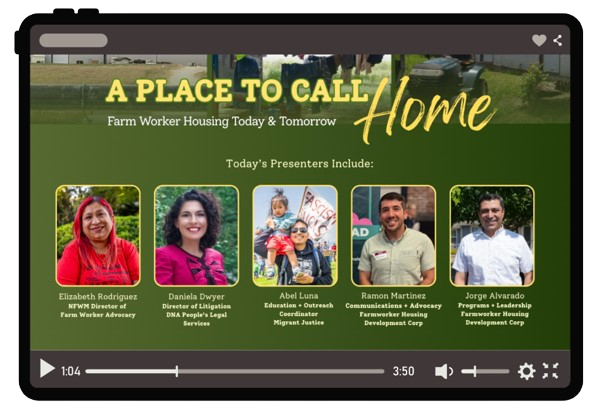Farm workers feed our nation, yet far too many live in housing that is unsafe, overcrowded, or unaffordable. Whether in employer-provided housing or in the private rental market, they often face substandard conditions, high costs, and systemic barriers that make stability out of reach. Housing is not just about shelter — it’s about health, dignity, and community. Without safe homes, farm workers face greater risks of illness, isolation, and instability.
👉 Watch the video below to hear directly from farm workers and advocates about the urgent need for housing justice.
Housing justice is one of the most urgent issues facing farm worker communities today. This page brings together key information, stories, and resources to help you understand the realities of farm worker housing and invite others into the conversation. Here, you’ll find:
-
Frequently Asked Questions that explain the factors shaping farm worker housing, including immigration status, wages, rural housing shortages, and long-standing policy gaps.
-
State-by-state snapshots showing how the housing crisis appears across the U.S.—from overcrowded trailers to unaffordable rents and limited seasonal housing options.
-
A recorded webinar that offers context, history, and lived experiences, along with ways communities can support farm worker–led solutions.
-
Partner and ally organizations leading efforts for safe, dignified, and affordable housing for farm workers, with links to learn more and get involved.
Together, we can educate, advocate, and accompany farm workers as they work for the housing stability every community deserves.
Explore the resources below and help amplify the message:
There is no harvest without homes.
Understanding Farm Worker Housing: FAQs
Questions about farm worker housing come up often — and for good reason. The realities are complex, shaped by factors such as immigration status, racism, wages, rural housing shortages, and decades of neglect in policy and oversight. This FAQ is designed to give you straightforward answers to some of the most common questions we hear.
As you read, remember that behind every statistic is a family working hard to put food on our tables. By learning more, you can help challenge misconceptions, share the truth, and join the movement for housing justice.
Farm worker housing varies widely based on employer, location, and immigration status.
Some workers—particularly those in the H-2A visa program—previously had access to employer-provided housing through October 2025, though this is no longer guaranteed.
Other housing options include employer-based seasonal or migrant camps, limited government-subsidized units for eligible documented workers, and the private rental market, where many undocumented workers rely on older trailers, converted garages, or subdivided apartments at high cost.
Across all types, common challenges remain: overcrowding, unsafe conditions, unstable leases, and barriers tied to income or documentation, leaving many without reliable or dignified housing options.
Source: USDA H-2A Program Guidance; NCFH “Facts About Farmworkers.”
Many farm workers earn low wages, face a limited supply of rural housing, and are excluded from most assistance programs. These barriers force them into overcrowded, unsafe, or temporary living situations. Studies have found that a significant portion of farm worker housing lacks basic amenities like adequate sanitation, ventilation, or safety features.
Oversight is also limited. There are no federal protections specific to farm worker housing, and only minimal enforcement through OSHA or state housing agencies. Many workers avoid reporting poor conditions due to fear of employer retaliation, leaving dangerous and unhealthy housing unaddressed.
Source: NCFH Housing Resources; OSHA Agricultural Housing Guidance.
There are government programs intended to support farm worker housing—such as USDA’s Section 514/516 and certain HUD programs—but most workers are never able to access them. Eligibility rules often require citizenship, legal documentation, income verification, and lengthy application processes, which exclude undocumented workers and many mixed-status families.
Even among those who are eligible, the number of available units is far too small to meet the need. As a result, fewer than 1% of farm workers receive any form of affordable housing assistance, leaving most without meaningful support.
Source: USDA Section 514/516 Program Data; NCFH Housing Resources.
For many farm workers, renting isn’t simply a matter of finding an apartment. Affordable rural housing is scarce, and the few available units are often priced far beyond what low-wage, seasonal workers can afford. National survey data shows many farm worker families live below the federal poverty line.
Even when housing is available, documentation requirements—such as Social Security numbers, credit checks, bank statements, or year-round income records—exclude undocumented workers and many mixed-status families. Seasonal workers also struggle to provide the up-front deposits and financial paperwork landlords require.
These combined barriers leave farm workers with far fewer rental options, often pushing them into overcrowded, unsafe, or temporary housing.
Source: NAWS 2019–2020; NCFH “Facts About Farmworkers,” 2022.
Housing is a critical determinant of health. Poor ventilation, mold, overcrowding, and proximity to pesticide-treated fields all heighten risks for respiratory illness, stress, heat-related injury, and other health problems. National and global health agencies, including the CDC and WHO, recognize housing quality as one of the most powerful predictors of wellbeing.
For farm workers, unsafe or unstable housing conditions can compound existing occupational risks, creating long-term impacts on physical and mental health.
Source: National Library of Medicine – Housing as a Social Determinant of Health (NIH).
Immigration status has a major impact on whether farm workers can access safe and stable housing. Undocumented workers are excluded from nearly all federal housing programs, including USDA’s Off-Farm Labor Housing. Even when some family members are documented, many mixed-status households face discrimination from landlords who require Social Security numbers, credit checks, or specific forms of ID.
These barriers push farm workers toward informal, overcrowded, or unsafe housing, leaving little stability and increasing vulnerability to exploitation.
Source: USDA Off-Farm Labor Housing Requirements; NCFH Housing Resources.
A Look at Farm Worker Housing in the U.S.
Housing challenges vary from state to state, but farm workers everywhere face unsafe, unaffordable, and unstable conditions. Explore these snapshots to see how the crisis shows up across the country:
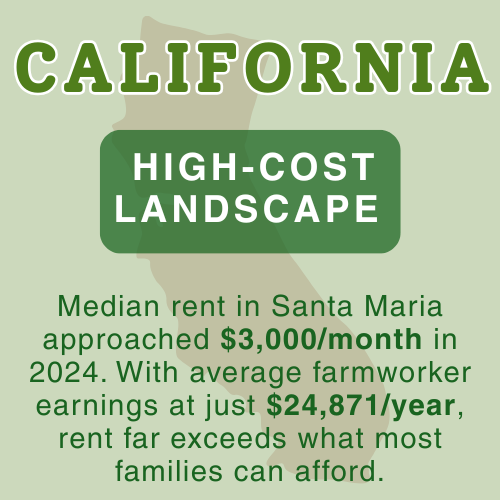
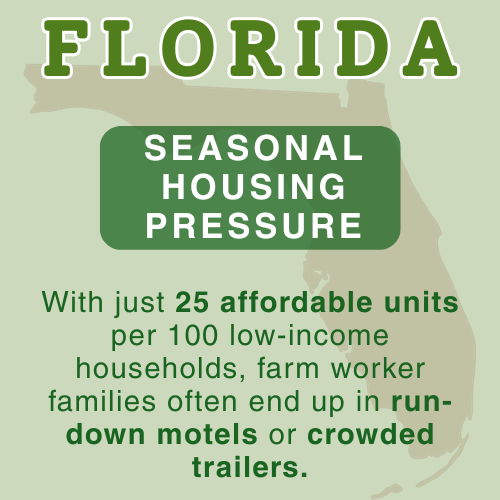
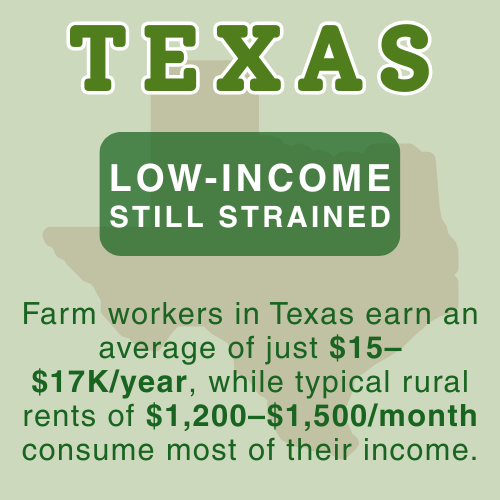
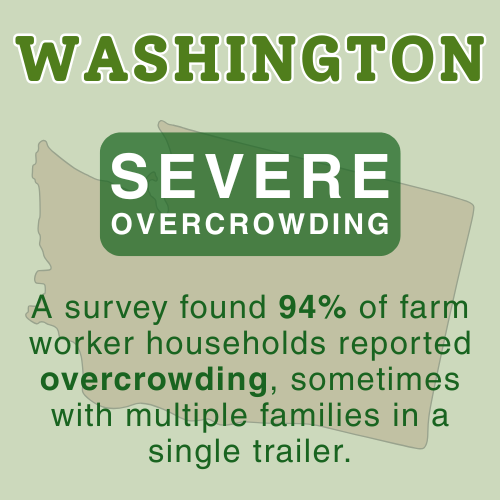
Learn More About Farm Worker Housing Realities
On our recent webinar, A Place to Call Home, farm worker partners, allies, and advocates offered a deeper look at the conditions shaping farm worker housing today. The conversation explored what homes actually look like for workers, the gaps in existing legal protections, and how forward-thinking organizations are working to expand access to safe, dignified housing in their communities.
👉 Watch the webinar replay here.
Partner & Ally Organizations Advancing Housing Justice
These partner and ally organizations are advancing housing justice in farm worker communities across the country. Their work offers research, stories, and opportunities for collective action.
-
Cesar Chavez Foundation
Provides affordable apartment housing for farm worker families and connects residents to resources through its Sí Se Puede programs, supporting community stability and wellbeing. - Farmworker Housing Development Corporation (FHDC)
In partnership with Pineros y Campesinos Unidos del Noroeste (PCUN), FHDC develops affordable housing for farm worker families and offers pathways to long-term stability, including homeownership tools and community-based support. - Migrant Justice
Advocates for policies that protect immigrant families from housing discrimination and expand access to safe, stable, and affordable homes. -
Ayudando Latinos A Soñar (ALAS)
Supports farm workers in the Half Moon Bay area through culturally rooted community programs and advocacy. ALAS also collaborates on affordable housing efforts that help “retired” farm workers move from isolated living conditions into dignified, accessible homes within the community. -
Farmworker Association of Florida (FWAF)
Conducts community-based research on housing and environmental health, including how unsafe and overcrowded housing contributes to heat stress and other risks. -
CIW (Coalition of Immokalee Workers)
Works with the Immokalee Fair Housing Alliance to expand safe, affordable housing options for farm worker families and strengthen community-led solutions. - FLOC (Farm Labor Organizing Committee)
Organizes with H-2A and migrant workers to advance fair wages, safe living conditions, and stronger protections across the supply chain.


